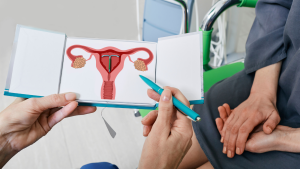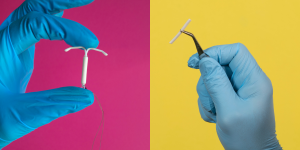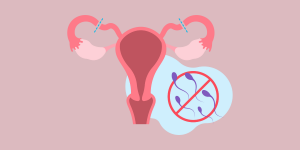
New Recommendations to Make IUD Insertion Less Painful
There is new guidance on pain management for IUD insertion and acknowledgement that providers often underestimate the pain patients feel during their procedures.

Did you know that bacterial sexually transmitted infections (STIs) are a common cause of infertility in women? And that they can also affect fertility in men?
Many people who are sexually active know they want to be a parent someday—but that day feels way far in the future. Young couples who have penis-in-vagina sex are often so focused on preventing an unintended pregnancy that they have given little thought about what will happen when they do want to become pregnant.
Preventing pregnancy until you are ready is very important, but it’s also important to protect your future fertility by preventing STIs.
Fertility is a person’s ability to get pregnant or get someone pregnant. Infertility is defined as the inability to get pregnant or get someone pregnant.
For couples having penis-in-vagina sex, infertility is usually diagnosed when they’ve been trying to conceive through frequent intercourse for at least a year and have not had any success.
Fertility issues can also include frequent miscarriages and the inability to carry a fetus to term.
About 13% of women ages 15 to 49 in the US have experienced some form of infertility.
Issues with the ovaries, fallopian tubes, uterus, or testicles can cause a couple to have trouble getting and/or staying pregnant. Medical conditions like endometriosis, polycystic ovary syndrome, pre-mature menopause, and varicocele (an issue with the veins in the testicles) are often the underlying cause.
Untreated STIs—especially chlamydia and gonorrhea—are another common cause of infertility.
In people with vaginas, untreated bacterial STIs can cause pelvic inflammatory disease (PID). This is an infection of the reproductive organs, including the uterus, fallopian tubes, and ovaries. About 10-15% of people with vaginas who have untreated chlamydia will get PID. It is possible to treat PID with antibiotics, but some people never know they have it.
It’s estimated that 2.5 million women in the United States will get PID in their lifetime. While the most common causes of PID are chlamydia or gonorrhea, PID also can be caused by other bacteria. About 1 in 8 women who have had PID have difficulty getting pregnant in the future.
PID can cause significant scarring of the uterus, fallopian tubes, and ovaries. Scar tissue in the fallopian tubes can lead to infertility because it blocks the path of the sperm toward the egg.
It can also lead to ectopic pregnancies by blocking the fertilized egg from traveling to the uterus. Ectopic pregnancies happen when an embryo begins to grow outside of the uterus, most often in the fallopian tubes.
Ectopic pregnancies are dangerous. If the embryo starts growing in a fallopian tube, the tube can burst and cause potentially life-threatening internal bleeding.
In people with penises, untreated STIs can cause inflammation and scarring of the genital tract. Gonorrhea can cause scarring of the urethra, which can interrupt ejaculation.
Gonorrhea and other bacterial STIs can also lead to epididymitis. The epididymis is the coiled tube at the back of the testicles that stores the sperm and then carries it out of the testicles. Epididymitis is an inflammation of this tube and can block sperm from being released.
Epididymitis can be treated with antibiotics.
In 2023, there were over 1.6 million cases of chlamydia and over 600,000 cases of gonorrhea reported in the United States. The CDC estimates that there are far more cases each year that go undiagnosed.
Symptoms of these bacterial STIs include:
But many cases of gonorrhea and chlamydia have no symptoms, especially in people with vaginas. If these STIs go undiagnosed and untreated, they can lead to PID and infertility. This is why screening is so important.
The CDC recommends that all sexually active women under 25 get screened for chlamydia and gonorrhea every year. Women older than 25 should get tested if they have a new partner, multiple partners, a partner who has been diagnosed with an STI, or a partner who has multiple partners at the same time.
The CDC also recommends that men who have sex men (MSM) get screened for chlamydia and gonorrhea at least once a year. MSM who have multiple partners or partners who have been diagnosed with an STI might want to be screened every three to six months.
The CDC does not recommend regular screening for men who have sex with women. That said, anyone who has symptoms or has a partner diagnosed with chlamydia or gonorrhea should get tested.
If you are experiencing infertility, ask your health care provider whether you should be tested for these and other STIs.
Taking steps to avoid contracting an STI can help protect your future fertility. If you are sexually active, there are ways to have safer sex. Some of these include:
Remember, getting an STI does not mean you will become infertile. Long-term health issues can be prevented if you are diagnosed and treated quickly.

There is new guidance on pain management for IUD insertion and acknowledgement that providers often underestimate the pain patients feel during their procedures.

Our reproductive health is an important part of our sexual health and our overall health. It includes our reproductive organs and our ability to get pregnant or get someone pregnant when we choose.

Anyone who is having penis-in-vagina sex runs the risk of getting pregnant every time they have sex. Even if it’s your first time. Even if you have your period. Even if it’s a full moon and Mercury is in retrograde.

LARC methods are safe, reliable, and prevent pregnancy for years. For many people they are a great choice, but everyone has personal preferences for what fits in to their lifestyle and health profile.

The Biden Administration proposed new rules designed to make getting contraception easier and less expensive.

A new study says we might be overestimating just how good tubal ligation (“getting your tubes tied” ) is at preventing pregnancy.

Public health experts have said that every case of congenital syphilis is a failure of STI screening and prenatal care. A new study looked more closely at cases to see what factors in a pregnant person’s life were most associated with congenital syphilis.

Women in states with restrictive abortion laws have few options today. And yet the prescriptions for birth control methods has fallen since the Dobbs decision.
ASHA believes that all people have the right to the information and services that will help them to have optimum sexual health. We envision a time when stigma is no longer associated with sexual health and our nation is united in its belief that sexuality is a normal, healthy, and positive aspect of human life.
ABOUT
GET INVOLVED
ASHA WEBSITES
GET HELP
© 2025 American Sexual Health Association